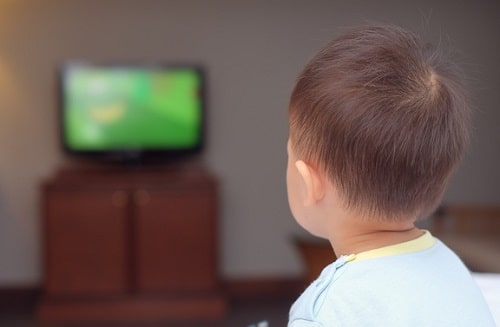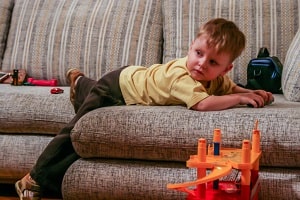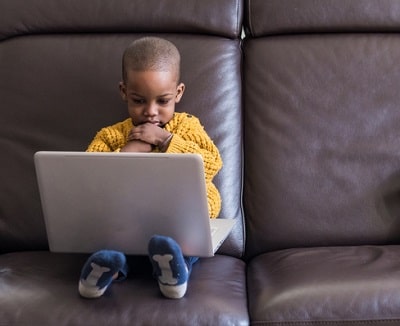Baby Talk: a Guide to Using Basic Sign Language to Communicate With Your Baby Epub
© 2009 – 2021 Gwen Dewar, Ph.D., all rights reserved

What are the effects of television on language learning?
Studies study a link between Television and linguistic communication development in young children. The more time kids spend watching tv, the more slowly they acquire to talk. What'south going on?
Some people conclude that the effects of goggle box on children are direct and negative. According to this view, television is noxious, similar cigarette fume. Cigarettes harm the lungs. Television amercement the listen.
But correlation isn't causation, and a more fine-grained analysis of the problem supports a very different conclusion —
TV is linked with slower language acquisition because TV time tends to readapt conversation time between babies and adults.
What the data really testify
To date, we lack strong evidence that watching telly — in moderation — leads to long-term deficits in cognitive evolution (Vedechkina and Borgonovi 2021).
That doesn't hateful there aren't whatever worries, or reasons for concern.
It'southward clear that inappropriate content can be upsetting.
When children lookout television that is violent or disturbing, they may feel threatened. This could pb to emotional distress and beliefs problems (due east.g., Fitzpatrick et al 2012).
In add-on, television has the potential to disrupt sleep, and disrupted sleep can interfere with a child'due south power to concentrate and learn.
(You can read more well-nigh the effects of television on sleep in this opens in a new windowParenting Science article.)
Researchers accept also proposed thatcertain types of content might interfere with the development of attention skills.
For instance, in one study, Frederick Zimmerman and Dmitri Christakis tracked toddlers over fourth dimension, and looked for links betwixt early telly viewing habits (before age three) and after attention issues.
The researchers foundno attention bug associated with watching high-quality, age-appropriate educational content. But the situation was unlike for vehement content, and for non-educational entertainment.
If kids were in the addiction of watching trigger-happy or non-educational telly programs before the age of three, they were more probable to experience attention problems at the age of four or 5 (Zimmerman and Christakis 2007).
Why? Some researchers speculate that the problem is caused by rapid pacing and abrupt edits. Just the testify is mixed (eastward.g., Cooper et al 2009). Nosotros need more studies to figure this out.
Another important business concern is background boob tube — what children experience when they are playing or learning in a room where a television is switched on.

Every bit you might expect, background television can be distracting. In one experiment, children'south play becomes less focused when a television was on in the background (Schmidt et al 2012).
In addition, there are hints that regular exposure to background television could lead to the development of attention problems (e.g., Gueron-Sela and Gordon-Hacker 2020; Ribner et al 2020). And background goggle box can expose children to distressing content. And so psychologists warn parents against watching tearing or otherwise inappropriate content while their immature children are present.
Finally, there's reason to think that television viewing could pose problems for learning language, merely not because tv set is intrinsically harmful.
On the reverse, sometimes television tin be helpful.
For instance, in a study tracking children from the age of 6 months, researchers discovered a positive link between vocabulary growth and watching certain educational programs.
Compared with children who didn't sentry any tv, children who watched Arthur, Clifford, Blue's Clues, Dragon Tales, or Dora the Explorer actually caused more vocabulary by the age of thirty months (Linebarger and Walker 2005).
And overall? What's the trend across studies? When researchers reviewed 76 published studies, they found evidence that preschoolers may actually benefit from watching high-quality, educational preschool television (Kostyrka-Allchorne et al 2017).
Then what makes television receiver problematic for children learning to talk?
Based on what researchers have learned so far, it's most likely a question of missed opportunities.
Babies and toddlers learn language about readily when we appoint them in one-on-one conversation. So if immature children spend lots of time watching Television set — and thereby lose opportunities to engage in conversation — they are at a disadvantage.
To run into what I mean, consider this show.
When it comes to learning speech, nothing beats a live conversation

Patricia Kuhl, a leading researcher in the field of language acquisition, has demonstrated this point in some elegant experiments on babies.
Kuhl and her colleagues presented 9-calendar month old American babies with an unfamiliar language—Mandarin Chinese. In one experiment, babies were allowed to interact with a existent, live Mandarin speaker. After 12 sessions, these babies showed an enhanced ability to discriminate certain speech sounds that are common in the Standard mandarin language.
Just when the experiment was repeated with another set of infants who watched only televised language tutors, the results were different. The babies exposed to Mandarin via TV were no more probable than command infants to discriminate Mandarin speech sounds (Kuhl et al 2003).
In both experiments, the Mandarin speakers gazed direct at the babies, discussed toys, and used that special, "infant-friendly" fashion of speaking known as "babe-directed speech."
The difference between experiments was the social factor. As Kuhl notes, "infants are obviously not computational automatons—rather, they might need a social tutor when learning a natural language" (Kuhl 2004).
Research suggests that chat, not listening to stories or watching TV, has the strongest positive effect on early linguistic communication development

This idea is supported by a report that fitted immature children, aged cypher to four years, with recording devices (Christakis et al 2009).
The devices allowed researchers to considerately mensurate how much adult conversation and television set each child experienced.
The results were intriguing.
Researchers discovered that social talk — one-on-i, dorsum-and-forth chat between adults and their children — was linked with meliorate language evolution. The more than time babies and toddlers were included in adult conversations, the more quickly their language skills improved.
Past contrast, listening to adult monologues — including storytelling — was only weakly correlated with language development. The effect of ii-way conversations was almost 6 times greater than the effect of merely listening to adults talk.
And TV?When researchers controlled for the amount of time that kids spent in conversation, the effect of television on children was neither positive nor negative.
It's a unmarried study, but subsequent research bolsters the idea that ane-on-ane conversation is the most powerful way for young children to learn.
The more fourth dimension kids spend in conversation with adults, the more likely they are to develop big vocabularies. Just overhearing adults talk? Kids can't sometimes learn that mode (Fitch et al 2020). But overall, children can learn much more from participating in conversation than they tin can from listening on the sidelines (Shneidman and Goldin-Meadow 2012; Shneidman et al 2013; Weisleder and Fernald 2013).
What almost other screen-based experiences, like video chat applied science? Can young children acquire language by talking with someone via video chat?

Maybe. But, if and so, information technology probably depends on the kid's understanding of how video chats dissimilar from traditional, passive television-watching. Kids demand to see that they're involved a real, interactive conversation.
To see what I hateful, consider an experimental written report conducted by Sarah Roseberry and her colleagues (Roseberry 2014).
The researchers randomly assigned a group of toddlers (24-30 months) to experience 1 of two types of adult conversation:
- an adult talking to them live, via Skype; or
- an developed who appeared to exist communicating via Skype just who was actually pre-recorded.
Nether both weather, toddlers attempted to communicate with the adult, but only the "alive" adult responded accordingly to the children'southward comments, questions, or facial expressions.
The pre-recorded adults talked in the manner of a television talk testify host – actualization to engage the audience, but obviously unable to react contingently to anything the kids did or said.
After these sessions, the toddlers were tested to see if they'd learned an unfamiliar word that the adult had used.
Only the kids who'd engaged in real, live conversations picked up the new vocabulary.
More recently, researchers performed a similar test on even younger children (12-25 months), and they obtained similar results: Babies who participated in interactive, online chats learned from the experience (Myers et al 2017).
Then young children can larn from video chats, merely here, too, in that location are limits.
In both of these studies, kids didn't simply start watching a stranger teaching them vocabulary. Video chats began with a warm-up period, during which adult greeted them by proper noun, and asked them to respond to personal questions about their contempo activities (due east.g., "Did yous similar playing with the blocks?").
These preliminaries may have helped the children realize that they were being addressed past a alive human being. And that could be crucial.
When researchers have tried testing children without taking these steps, young children have failed to learn from live video chatting (Troseth et al 2018; Strouse et al 2018).
So what's the takeaway?
There's reason to limit children's screen fourth dimension.
Information technology appears that certain types of screen content — violent, historic period-inappropriate content — tin can trigger distress and (peradventure) contribute to attention bug. Television can disrupt sleep. Background Television receiver may distract a kid's focus.
Considering of these factors — and because the evidence is at all-time inconclusive about possible benefits for babe viewers — the opens in a new windowAmerican University of Pediatrics (AAP) discourages "the utilise of screen media other than video chatting" — for children under the age of 18
For older children, the APP recommends that that parents "limit screen use to no more than one hr or less per day of high-quality programming," and that children consume media with their caregivers — not past themselves (American Academy of Pediatrics 2016).
But when it comes to learning to talk, the nigh of import takeaway concerns the effects of alive conversations between children and adults.
It isn't and so much that language delays are caused by watching television. It's that children benefit about when they engage in conversations with other people. Screen time tin create bug if displaces conversation time and other of import, real-globe, developmental activities. Our best bet? Give our kids lots of opportunities to hash out, explore, ask questions, and respond.
Helping babies learn language: More tips
Acquire more near your infant's developing language skills from these Parenting Science articles:
- opens in a new windowBabe talk 101: How infant-directed speech helps babies larn language
- opens in a new windowWhen do babies speak their first words?
- opens in a new windowTalking to babies: How eye contact helps babies tune in
- opens in a new windowBaby sign language: A guide for the science-minded parent
- opens in a new windowCan babies sign earlier they speak?
And if you're wondering what your baby might exist thinking when he or she watches TV, check out these articles about the fashion infants react to the social interactions of others:
- opens in a new windowMoral sense: Do babies know right from wrong?
- opens in a new windowBabies expect fairness, and adopt people who behave with fairness
- opens in a new windowExercise babies experience empathy?
References: The furnishings of television on children who are learning to talk
American Academy of Pediatrics. 2016. Where we stand: Screen time. healthy children.org, https://www.healthychildren.org/English/family unit-life/Media/Pages/Where-We-Stand up-TV-Viewing-Time.aspx. Accessed 11 May 2021.
Cooper NR, Uller C, Pettifer J, and Stolc FC. 2009. Conditioning attentional skills: examining the furnishings of the pace of television editing on children's attention. Acta Paediatr. 2009 Jun iv. [Epub ahead of print].
Christakis DA, Gilkerson J, Richards JA, Zimmerman FJ, Garrison MM, Xu D, Grey S, and Yapanel U. 2009. Audible Television and Decreased Adult Words, Baby Vocalizations, and Conversational Turns: A Population-Based Study. Arch Pediatr Adolesc Med. 163(6):554-558.
Crawley AM, Anderson DR, Wilder A, Williams Thou, and Santomero A. 1999. Effects of repeated exposures to a unmarried episode of the television program Blue's Clues on the viewing behaviors and comprehension of preschool children. J Educ Psychol. 91: 630-638.
Fitzpatrick C, Barnett T, Pagani LS. 2012. Early on exposure to media violence and afterward child aligning. J Dev Behav Pediatr. 33(4):291-seven
Geist EA, Gibson Thou. 2000. The effect of network and public education tv programs on 4 and v yr olds ability to attend to educational tasks. J Instructional Psychol. 27:250-261.
Gueron-Sela N and Gordon-Hacker A. 2020. Longitudinal Links Between Media Use and Focused Attention Through Toddlerhood: A Cumulative Risk Approach. Front Psychol. eleven:569222.
Hirsh-Pasek 1000, Adamson LB, Bakeman R, Owen MT, Golinkoff RM, Pace A, Yust PK, Suma M. 2015. The Contribution of Early Communication Quality to Low-Income Children's Language Success. Psychol Sci. 26(7):1071-83.
Kostyrka-Allchorne Thou, Cooper NR, and Simpson A. 2017. The relationship between television exposure and children's cognition and behaviour: a systematic review. Dev. Rev. 44: 19–58.
Kuhl PK. 2004. Early language acquisition: Corking the speech communication code. Nature Neuroscience five: 831-843.
Kuhl PK, Tsao FM, and Liu HM. 2003. Foreign-language feel in infancy: effects of short-term exposure and social interaction on phonetic learning. Proc Natl Acad Sci U S A. 100(15):9096-101.
Lillard AS and Peterson J. 2011. The immediate touch of different types of television on young children's executive part. Pediatrics 128: 644–649.
Linebarger DL and Walker D. 2005. Infants' and toddlers' television viewing and language outcomes. Am. Behav. Sci. 48 624–645.
Myers LJ, LeWitt RB, Gallo RE, Maselli NM. 2017. Baby FaceTime: tin toddlers learn from online video chat? Dev Sci. twenty(4).
Nathanson AI, Aladé F, Abrupt ML, Rasmussen EE, Christy Yard. 2014. The relation between television exposure and executive office among preschoolers. Dev. Psychol. 50: 1497–1506.
Ribner Advert, Barr RF, Nichols DL. Pediatr Res. 2020. Groundwork media use is negatively related to language and literacy skills: indirect furnishings of self-regulation. 2020 Jun 10. doi: x.1038/s41390-020-1004-5. Online ahead of print.
Roseberry S, Hirsh-Pasek One thousand, and Golinkoff R. 2014. Skype Me! Socially Contingent Interactions Assist Toddlers Acquire Language. Kid Dev. 85(3): 956–970.
Schmidt ME, Pempek TA, Kirkorian HL, Lund AF, Anderson DR. 2008. The effects of background boob tube on the toy play behavior of very young children. Kid Dev 79(4):1137-51.
Shneidman LA, Goldin-Meadow S. 2012. Language input and acquisition in a Mayan village: how of import is directed speech? Dev Sci. xv(5):659-73.
Shneidman LA, Arroyo ME, Levine SC, and Goldin-Meadow S. 2013. What counts as effective input for give-and-take learning? J Kid Lang. forty(3):672-86.
Troseth GL, Strouse GA, Verdine BN, Saylor MM. 2018. Allow'south Chat: On-Screen Social Responsiveness Is Not Sufficient to Support Toddlers' Discussion Learning From Video. Front Psychol. 9:2195.
Vedechkina M and Borgonovi F. 2021. A Review of Evidence on the Role of Digital Technology in Shaping Attention and Cerebral Control in Children. Front Psychol. 12:611155.
Weisleder A and Fernald A. 2013. Talking to children matters: early language experience strengthens processing and builds vocabulary. Psychol Sci. 24(11):2143-52.
Content last modified 5/21
Some of the text in this article appeared in an earlier version of the commodity by the aforementioned author.
Prototype credits for "Effects of television on children learning to talk"
title epitome of child watching Boob tube past Yaoinlove / istock
image of boy lying on couch, distracted by dmakig /istock
image of female parent talking face-to-face with toddler by JBryson/istock
Source: https://parentingscience.com/effects-of-television-on-children-learning-speech/
0 Response to "Baby Talk: a Guide to Using Basic Sign Language to Communicate With Your Baby Epub"
Post a Comment